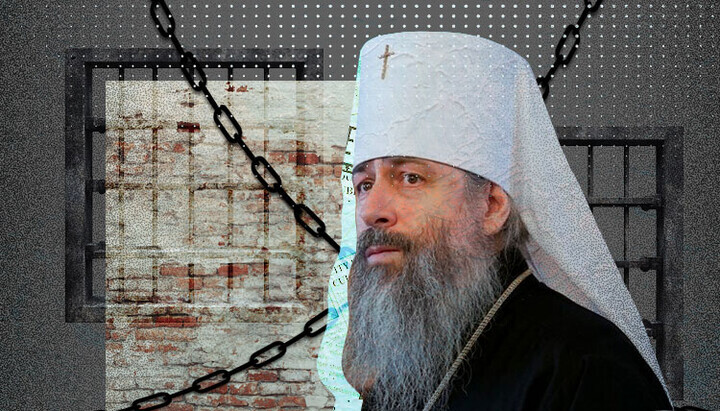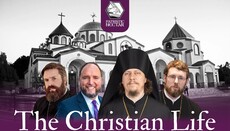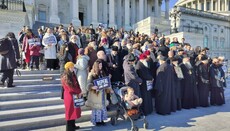The Met. Arseniy Case: Freedom as Captivity

The authorities “released” the Metropolitan... only to throw him behind bars again.
On October 23, 2025, the Dnipro Court of Appeal made a decision that millions of believers had been waiting for: the abbot of the Sviatohirsk Lavra, Met. Arseniy, was released from custody on bail. For a second, everyone who supported the bishop felt that their shepherd had finally been given a chance to breathe freely. But very soon it became clear: that hope was false.
The judges decided to release the metropolitan on bail of ₴1,514,000 [about $36,000]. They hesitated for a long time before issuing such a verdict. But the Archbishop’s health had deteriorated so badly that even the representatives of Ukrainian justice understood: he might die in prison. For the people who helped gather the money for bail, Met. Arseniy is more than just a name. He is a father, a man of prayer, someone who did a great deal to raise the Sviatohirsk monastery from ruin and oblivion. On Monday, October 27, these people paid the required sum, fulfilling everything the law demands in such cases.
And then, the next day—October 28, at 4:59 PM—although the defense had not yet submitted the documents confirming payment of bail to the pretrial detention center, the Metropolitan walked out of the detention facility. But only a few seconds later, he was surrounded by SBU agents.
The hierarch had neither money nor a phone with him. He was not met by his spiritual children or by the brethren of his monastery. The first thing he saw after weeks in a cell was once again an official car and SBU officers, who took him to the investigator of the Second Directorate of the SBU in the Donetsk and Luhansk regions. Thus ended his brief freedom, which lasted less than a minute.
The SBU officers explained the new detention by claiming that “the suspect might escape”. The statement sounded like mockery. A metropolitan who had been strongly advised to undergo heart surgery, who could barely move, might escape! Moreover, Met. Arseniy had never given the slightest reason to draw such conclusions. And not only because he had no desire to “flee” from a human court, but because he had lived his entire life as “a shepherd who lays down his life for the sheep” (John 10:11).
Perhaps, it is precisely this fact that so angers the modern persecutors of the Church? Maybe, it seems especially suspicious to them? After all, they can never understand that if a monk ever wishes to “flee” somewhere, it is only to his monastery, for he has long since fled from the world, from the very day of his monastic tonsure.
During the Metropolitan’s detention, a lawyer from the Free Legal Aid Center was present, but, for obvious reasons, he was unable to offer any real assistance. When Met. Arseniy’s actual lawyers learned of what had happened, they rushed to the SBU office demanding his release, since his detention was clearly unlawful. The investigator refused simply because, apparently, he had received an order. Thus, without a trial and without proven guilt, the hierarch was once again imprisoned.
From the evening until midnight, the metropolitan remained at the SBU office. Then a new chapter in the chain of humiliations and abuses began.
Exactly at midnight, the metropolitan was taken to the emergency hospital in Dnipro. A cardiologist glanced at the documents recommending heart surgery but paid them no attention. Without even questioning the patient, quickly measuring blood pressure, and not asking a single question, she ruled: hospitalization was unnecessary.
Next came an examination at a psychiatric hospital. Alcohol and drug tests—a standard procedure—but here again it felt like a mockery. After that, at night the bishop was transferred to Temporary Detention Facility No. 1 in Dnipro.
At the gates of the detention center, a huge line had formed. The Metropolitan spent an hour and a half in the car with no way to get out. Around three in the morning, he was finally allowed inside. Bureaucracy then took another hour. Only at 4 AM was Met. Arseny placed in a cell.
Can you imagine what a person with serious heart problems endured during all this time—almost twelve hours on his feet, in the middle of the night? This is how his first day “in freedom” came to an end.
Today, October 29, the Shevchenkivskyi District Court was scheduled to hear the lawyers’ complaints about the unlawful detention. At the time of writing, the outcome of this hearing is unknown. At the same time, the Sobornyi District Court is to determine the preventive measure under a new article (436-2) of the Criminal Code of Ukraine, “justifying the aggression of the Russian Federation”. The prosecution demands that the Metropolitan remain in custody. The date of the hearing on this matter is not yet known.
Amazingly, this is not the only case. On October 29, at 1:00 PM a hearing was scheduled in the Sloviansk City District Court—yet another case against the Metropolitan. Its outcomes are also currently unknown.
What is clear, however, is the principle by which the repressive machine operates against Met. Arseniy: the more severe his illnesses and frailties, the more cases are brought against him. With a single purpose: to break him. If not spiritually, then physically.
On September 30, the Metropolitan was already taken to the hospital. At that time, doctors recommended heart surgery. The arrhythmologist insisted on urgent surgical intervention. But now, a month later, Met. Arseniy spends the night without sleep, under pressure from the SBU, enduring humiliation and long lines at the detention center doors. And all of this is based on fabricated charges. Few doubt that all these sufferings are the price of his fidelity to the Church.
"If they persecuted Me, they will also persecute you" (John 15:20).
We are no longer surprised that these words of Christ are literally coming true today. Everything that is happening to Metropolitan Arseniy is a vivid illustration of the Savior’s words. And one should not think that in the case of the hierarch, this is merely about a person arrested for political reasons. No: it is about the Church, which is once again being forced to its knees.
New 1930s: Church and State: A Hundred Years Later
When you read the Church chronicles of the past two years, it seems as if time is repeating itself. Because exactly one hundred years ago, in the 1920s, in Kyiv, Kharkiv, and Odesa, priests, monastics, and laypeople were being interrogated. The accusations sounded painfully familiar: “counter-revolutionary activity”, “ties with the enemy”, “spreading hostile ideology”. Today, they have added “justifying aggression”, which, in essence, carries the same meaning.
Then, as now, it all began with arrests and searches. Next came interrogations and detentions. After that, Solovki. Today we see the same story, only with different settings, and no Solovki yet.
The Sviatohirsk Lavra survived two wars, destruction, and evacuation. Later, it revived, becoming even more beautiful than before. Yet, a hundred years later, its abbot—a man with a serious heart condition who needs surgery—is once again imprisoned. And this is happening in the 21st century, in a country that calls itself democratic.
When the Bolsheviks destroyed monasteries, they claimed they were fighting not against God, but against “religious propaganda” and “bourgeois reaction”. Today, other “Bolsheviks” claim they are fighting not against the Church, but against “enemy influence” on it.
Met. Arseniy did not accuse anyone of anything, did not call for resistance or revolution, and did not speak any other seditious words. He spoke of peace and love, forgiveness and repentance. And above all, he prayed. He remained in the monastery even when hostilities raged around it, and the monastery was shelled and could have been destroyed. He did not flee but stayed with the brethren and the faithful.
He buried monks and civilians, served under fire, and fed refugees. Yet today, he is being judged simply for the fact of his belonging to the Church. And for the very fact that the Lavra continues to be an island where Christ is loved more than the world.
"And you will be hated by all for My name’s sake; but he who endures to the end will be saved" (Matthew 10:22).
These words are not about ancient times. They are about us, about the present day, about Met. Arseniy, sitting in a detention cell. He has become a witness and a confessor. And not by his own choice, but because our Church—his Church—is once again going through the cross.
We often think that the time of confessors belongs only to books and history, that New Martyrs are a terrifying chapter of the past. But the story of Met. Arseniy shows that this chapter is not closed. Persecution has not disappeared: it has merely changed its language and form.
Today, tens of thousands of people are praying for him, just as they once prayed for hierarchs taken to the gulag. Back then, these prayers seemed like voices crying into the void, yet they were exactly what the Church needed.
And now, in this darkness that is once again descending upon our Church, it is the same breath of prayer that keeps the Church alive.
The Sviatohirsk Lavra is praying, thus resisting persecution. Met. Arseniy is praying, and however strange it may seem, he, not his persecutors, is victorious. And no matter how hard judges, prosecutors, and investigators try, they cannot revoke Christ’s words: “Fear not, little flock; for it is your Father's good pleasure to give you the kingdom” (Luke 12:32). Because as long as there is even one person in our country who has not betrayed their faith, persecution cannot prevail.
And as long as the Church responds to violence with prayer, it remains the freest power in the world.









